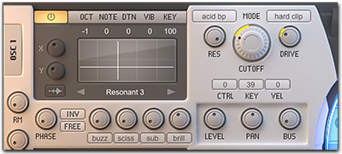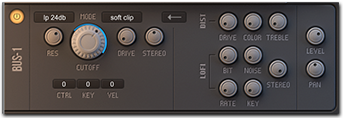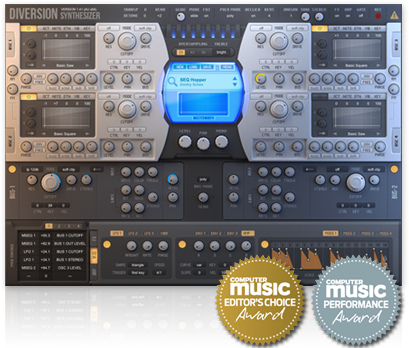Diversion
Diversion is a versatile, high quality software synthesizer, designed for use in any genre of professional electronic music production. Diversion takes the full advantage of modern processors to bring you the perfect sound quality that fits standards of hardware synthesizers.
|
"Very full feature-set, Impeccable sound quality, Plenty of ready to go presets, Sounds incredibly modern, Arguably unparalleled tonal controls, Pushes current technology to the limits". |
Listen to the audio demo
Take a short tour through the several Diversion's presets. No external FXs are involved, pure Diversion's sound:
Sound generation
 Diversion offers 4 oscillators with a wide range of different waveforms with a near to zero level of aliasing. The oscillators generate sounds in real-time by using our algorithms, which don't degrade the sound quality at high frequencies. All waveforms have two independent parameters X and Y allowing you to adjust the timbre of the produced sound. The oscillators also feature such synthesis techniques as FM, RM, wave shaping and filtering.
Diversion offers 4 oscillators with a wide range of different waveforms with a near to zero level of aliasing. The oscillators generate sounds in real-time by using our algorithms, which don't degrade the sound quality at high frequencies. All waveforms have two independent parameters X and Y allowing you to adjust the timbre of the produced sound. The oscillators also feature such synthesis techniques as FM, RM, wave shaping and filtering.
Since version 1.2 Diversion offers comprehensive Wavetable Editor, which allows to load arbitrary single cycle WAV files. With new Wavetable Editor it is possible to edit waveforms both in time and frequency space as well as apply different effects. Since version 1.3, Diversion provides sample playback with granular synthesis and output audio recording.
Bus processors
 Two bus processors in Diversion allow you to transform the oscillators' output into a wide variety of possible sounds. Each bus processor consists of a stereo filter with lots of different modes, distortion and LO-FI section. We have implemented many filter modes and types of saturation stages to bring you a great armoury for creating arbitrary patches, including popular Trance, Psy, Dub Step and Ambient sounds.
Two bus processors in Diversion allow you to transform the oscillators' output into a wide variety of possible sounds. Each bus processor consists of a stereo filter with lots of different modes, distortion and LO-FI section. We have implemented many filter modes and types of saturation stages to bring you a great armoury for creating arbitrary patches, including popular Trance, Psy, Dub Step and Ambient sounds.
Effects
 Diversion uses two flexible FX lines for a separated processing of each bus processor?s output. With the separated FX processing you can make lots of layered sounds, even which has two parts located in two fully independent sound spaces. Up to 8 effect instances can be stacked in one FX line, which is enough to create any desired processing chain.
Diversion uses two flexible FX lines for a separated processing of each bus processor?s output. With the separated FX processing you can make lots of layered sounds, even which has two parts located in two fully independent sound spaces. Up to 8 effect instances can be stacked in one FX line, which is enough to create any desired processing chain.
Oversampling
Typically, after a non-linear processing of the waveform inside the oscillators and bus processors, digital aliasing can occur. Diversion takes care of this by using oversampling up to 8X within a whole processing path, excluding FX section. Models of all processing modules in Diversion are designed using at least 2X oversampling. This allows Diversion to achieve a perfect sound quality with an insignificant level of aliasing.
Modulation
 Many parameters in Diversion can be modulated by 4 LFOs, 4 ADSR Envelopes, 4 MSEGs and one XY-controller, called Master Morph. These options, along with use of the Modulation Matrix, can really breathe life into a sound. Of course, automation and midi controllers are supported.
Many parameters in Diversion can be modulated by 4 LFOs, 4 ADSR Envelopes, 4 MSEGs and one XY-controller, called Master Morph. These options, along with use of the Modulation Matrix, can really breathe life into a sound. Of course, automation and midi controllers are supported.
Arpeggiator and Trance Gate
 Last but not least, Diversion features a 32-step Arpeggiator / Sequencer and a 16-step Trance Gate module, which turns Diversion into a full-fledged workstation.
Last but not least, Diversion features a 32-step Arpeggiator / Sequencer and a 16-step Trance Gate module, which turns Diversion into a full-fledged workstation.
System requirements
WARNING! Diversion's audio engine may consume lots of CPU power. It is highly recommended to run Diversion on Intel Core i5 or i7 processors. Please make sure you have the following system specifications:
- Modern processor with SSE3 support
- Windows Vista or higher
- OSX 10.9.X or higher
- VST 2.4 or AU compatible host software
Try it out
Version: 1.41 (changelog)
Demo limitations: noise sample is played every 90 seconds
Formats: VST/AU, 32/64bits

